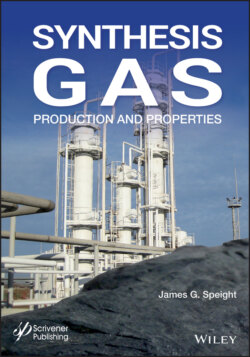Читать книгу Synthesis Gas - James Speight G., James G. Speight - Страница 14
1.2.1 Natural Gas and Natural Gas Hydrates
ОглавлениеIt is rare that crude oil and also heavy crude oil do not occur without an accompanying cover of gas (Speight, 2014a, 2019b). It is therefore important, when describing reserves of crude oil, to also acknowledge the occurrence, properties, and character of the natural gas. In recent years, natural gas has gained popularity among a variety of industrial sectors. Natural gas burns cleaner than coal or crude oil, thus providing environmental benefits. Natural gas is distributed mainly via pipeline, and some in a liquid phase (LNG) transported across oceans by tanker.
Assuming that the current level of natural gas consumption for the world is maintained, the reserve would be enough to last for another 64 years. However, in this estimation of natural gas longevity, factors such as the increase in annual consumption, the discovery of new reservoirs, and advances in discovery/recovery technology, and utilization of natural gas hydrates are not included. As a result of discoveries of gas in tight shale formations – which has offset more than the annual consumption – the world reserves of natural gas have been in a generally upward trend, due to discoveries of major natural gas fields.
Natural gas liquids (NGLs) – which are the higher-boiling constituents of natural gas separated from natural gas at a gas processing plant, and include ethane, propane, butane, and pentanes – have taken on a new prominence as shale gas production has increased and prices have fallen (Ratner and Tiemann, 2014). As a result, most producers are accepting the challenges with the opportunism and have shifted production to tight formations, such as the Bakken formation in North Dakota and Montana, to capitalize on the occurrence of natural gas liquids in shale gas development (Speight, 2013f; Sandrea, 2014; Speight, 2015a).
Methane hydrates (also often referred to as methane clathrates) is a resource in which a large amount of methane is trapped within a crystal structure of water, forming a solid similar to ice (Chapter 1) (Collett, 2009). Methane hydrates exist as methane (the chief constituent of natural gas) trapped in a cage-like lattice of ice which, if either warmed or depressurized (with suitable caution), revert back to water and natural gas. When brought to the surface of the Earth, one cubic meter of gas hydrate releases 164 cubic meters of natural gas.
Gas hydrates occur in two discrete geological situations: (i) marine shelf sediments and (ii) on-shore Polar Regions beneath permafrost (Kvenvolden 1993; Kvenvolden and Lorenson, 2000). These two Hydrates occur in these two types of settings because these are the settings where the pressure-temperature conditions are within the hydrate stability field (Lerche and Bagirov, 1998). Gas hydrates can be detected seismically as well as by well logs (Goldberg and Saito, 1998; Hornbach et al., 2003).
When drilling in crude oil-bearing and gas-bearing formations submerged in deep water, the reservoir gas may flow into the well bore and form gas hydrates owing to the low temperatures and high pressures found during deep water drilling. The gas hydrates may then flow upward with drilling mud or other discharged fluids. When the hydrates rise, the pressure in the annulus decreases and the hydrates dissociate into gas and water. The rapid gas expansion ejects fluid from the well, reducing the pressure further, which leads to more hydrate dissociation and further fluid ejection.
